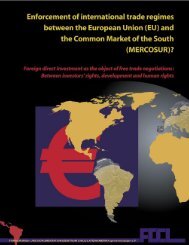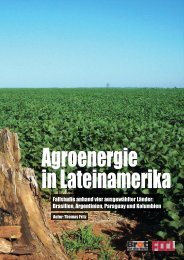(EU) and the Common Market of the South (MERCOSUR)? - FDCL
(EU) and the Common Market of the South (MERCOSUR)? - FDCL
(EU) and the Common Market of the South (MERCOSUR)? - FDCL
Create successful ePaper yourself
Turn your PDF publications into a flip-book with our unique Google optimized e-Paper software.
“German direct investment in Latin America plays a more important role <strong>the</strong>n<br />
can be deduced from <strong>the</strong> numbers on <strong>the</strong> stock <strong>of</strong> direct investment. Independent<br />
<strong>of</strong> <strong>the</strong> question how high German direct investment in Latin America really<br />
is, this region remains <strong>of</strong> strategical importance for <strong>the</strong> German economy.<br />
Apart from western Europe, Latin America is <strong>the</strong> only region in which German<br />
companies occupy key positions in certain industrial sectors, for example, in<br />
<strong>the</strong> automobile, chemical, pharmaceutical, electrotechnics <strong>and</strong> engineering<br />
sectors.” 124<br />
This “imprecision” regarding <strong>the</strong> question “how high German direct investment<br />
in Latin America really is” can be explained, on <strong>the</strong> one h<strong>and</strong>, by <strong>the</strong> reinvestment<br />
<strong>of</strong> companies who have already established residency, which by definition cannot<br />
be registered by <strong>the</strong> criteria <strong>of</strong> foreign investment flows, <strong>and</strong> on <strong>the</strong> o<strong>the</strong>r h<strong>and</strong>, by<br />
investment flows via third countries, 125 so that <strong>the</strong> real origin <strong>of</strong> capital is not recorded<br />
by <strong>the</strong> central bank`s statistics. German direct investment in Latin America, which is<br />
recorded by FDI-statistics, concentrates mainly on Argentina (which has 7.9% <strong>of</strong> <strong>the</strong><br />
total amount <strong>of</strong> German foreign investment in Latin America), on Mexico with 21.5%<br />
<strong>and</strong>, with <strong>the</strong> highest percentage <strong>of</strong> investment, on Brazil with 26.4%. 126<br />
Since <strong>the</strong> second half <strong>of</strong> <strong>the</strong> nineties Spanish corporations have concentrated<br />
<strong>the</strong>ir foreign investment in Latin America on Argentina, Brazil <strong>and</strong> Chile, focussing for<br />
<strong>the</strong> most part on <strong>the</strong> take-overs <strong>of</strong> former state-owned companies in <strong>the</strong> services,<br />
telecommunication <strong>and</strong> banking sectors, but also on <strong>the</strong> industrial areas <strong>of</strong> energy<br />
<strong>and</strong> petroleum all over Latin America. 127 Spanish corporations – unlike <strong>the</strong> German<br />
ones, for example – have been <strong>the</strong> leaders in <strong>the</strong> participation in <strong>the</strong> wave <strong>of</strong> privati-<br />
124 Own translation <strong>of</strong> <strong>the</strong> following original text: “[d]ie deutschen Direktinvestitionen in Lateinamerika spielen eine<br />
wichtigere Rolle, als anh<strong>and</strong> der Angaben zum Best<strong>and</strong> der Direktinvestitionen erkennbar ist. Unabhängig von<br />
der Frage, wie hoch die deutschen Direktinvestitionen in Lateinamerika tatsächlich sind, bleibt diese Region<br />
von strategischer Bedeutung für die deutsche Wirtschaft. Außerhalb Westeuropas ist Lateinamerika die einzige<br />
Weltregion, in der deutsche Unternehmen Schlüsselpositionen in bestimmten Industriesektoren innehaben.<br />
Beispiele dafür sind die Sektoren Kfz, Chemie, Pharmazie, Elektrotechnik und Maschinenbau.” Taken from Rösler,<br />
Peter: Ausl<strong>and</strong>sinvestitionen in Lateinamerika, Ibero-Amerika Verein, July 30, 2003.<br />
125 “So entfielen z.B. 2001 im Falle Deutschl<strong>and</strong>s von den Direktinvestitionen in Lateinamerika und der Karibik<br />
auf Barbados ca. 0,3 Mrd, auf die Bermudas ca. 3 Mrd, auf die Britischen Jungferninseln ca. 0,2 Mrd, auf die<br />
Kaiman-Inseln ca. 5,6 Mrd und auf die Niederländischen Antillen ca. 1 Mrd. Auch die US-Unternehmen investierten<br />
nennenswerte Beträge in den Steueroasen. 2002 wurden dort folgende US-Direktinvestitionsbestände registriert:<br />
Barbados US$ 1,5 Mrd, Bermuda US$ 68,9 Mrd und <strong>and</strong>ere Steueroasen US$ 29,3 Mrd. Insgesamt waren<br />
also die karibischen Steueroasen mit einem Drittel an den deutschen und mit 37 % an den US-amerikanischen<br />
Direktinvestitionen in Lateinamerika und der Karibik beteiligt.” Rösler, Peter: Ausl<strong>and</strong>sinvestitionen in Lateinamerika,<br />
Ibero-Amerika Verein, July 30, 2003. Own translation: “In 2001 in Germany’s case, for example, <strong>of</strong> <strong>the</strong> direct<br />
investment placed in Latin America <strong>and</strong> <strong>the</strong> Carribbean around 0.3 billion US-dollars went to Barbados, 3 billion<br />
US-dollars to <strong>the</strong> Bermudas, around 0.2 billion to <strong>the</strong> British Virgin Isl<strong>and</strong>s, around 5.6 billion to <strong>the</strong> Caiman Isl<strong>and</strong>s<br />
<strong>and</strong> around 1 billion to <strong>the</strong> Ne<strong>the</strong>rl<strong>and</strong>s Antilles. U.S. companies also invested substantial sums in <strong>the</strong> tax havens.<br />
In 2002 <strong>the</strong> following U.S. direct investment stocks were registered <strong>the</strong>re: Barbados 1.5 billion US-dollars, Bermuda<br />
68.9 billion US-dollars <strong>and</strong> o<strong>the</strong>r tax havens 29.3 billion US-dollars. The Carribbean tax havens <strong>the</strong>reby made up<br />
one third <strong>of</strong> German <strong>and</strong> 37% <strong>of</strong> U.S. direct investment in Latin America <strong>and</strong> <strong>the</strong> Carribbean.”<br />
126 Ibid.<br />
127 United Nations Conference on Trade <strong>and</strong> Development (UNCTAD): World Investment Report 2003 - FDI Policies for<br />
Development: National <strong>and</strong> International Perspectives, New York/Geneva 2003.<br />
59









